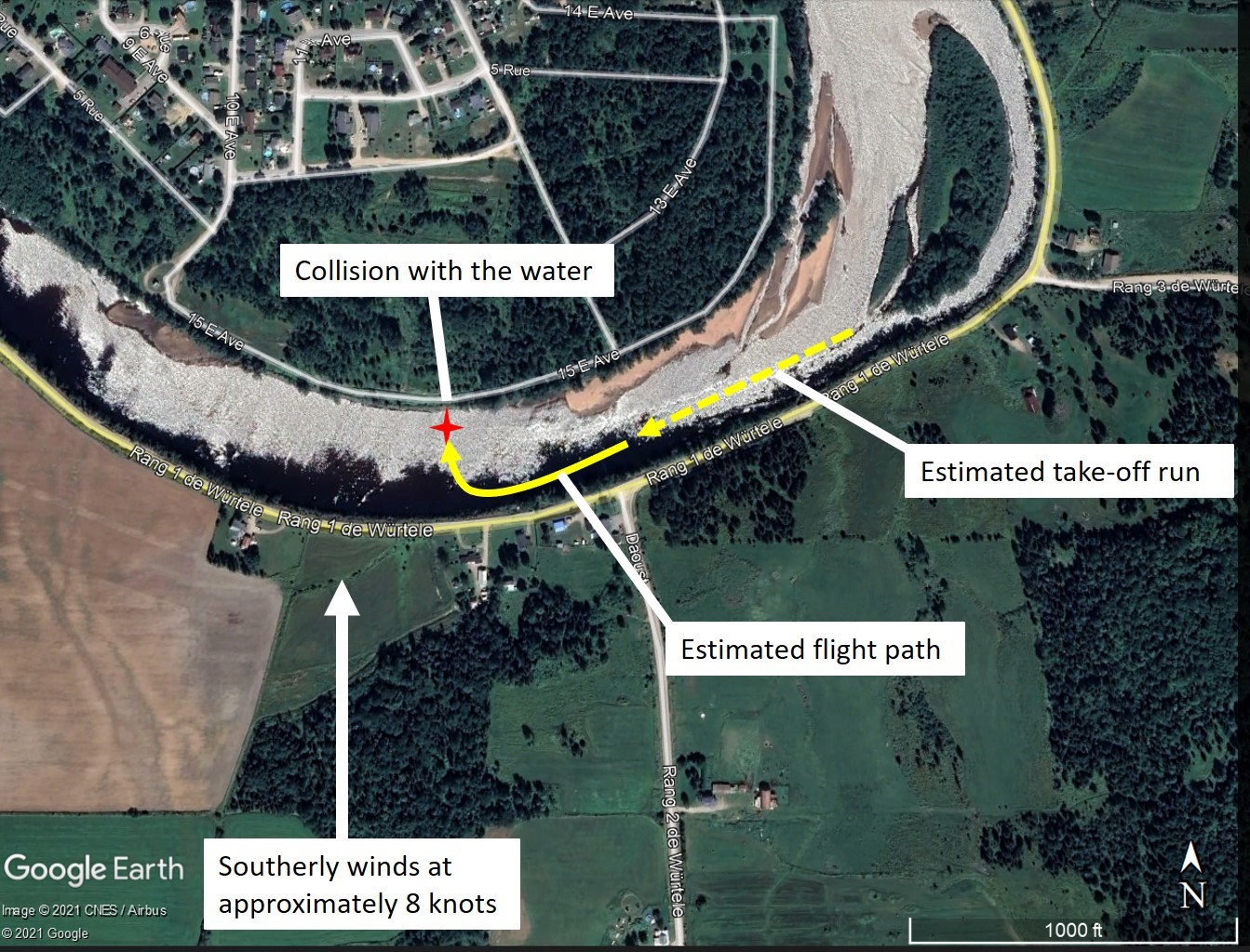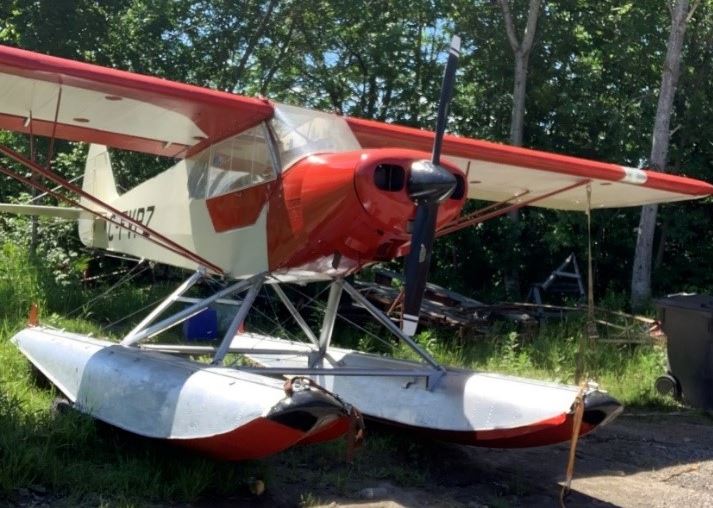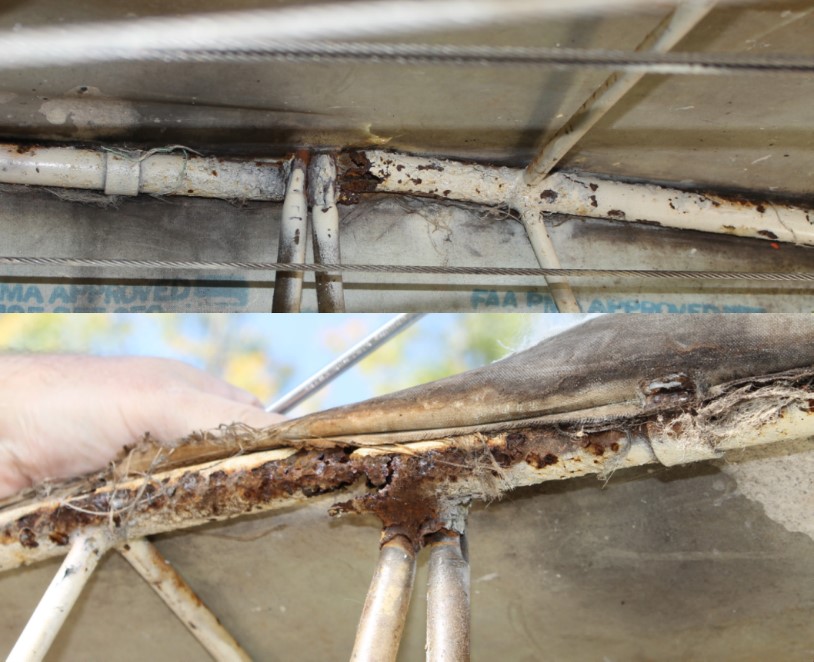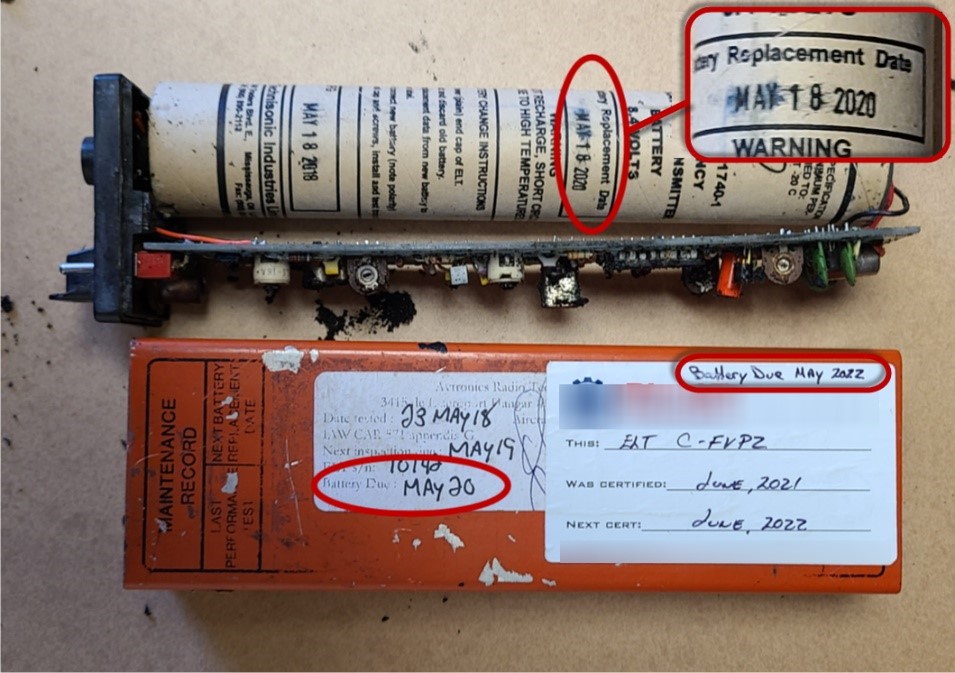Collision with water and capsizing
Privately registered
Piper PA-18S-150 (floatplane), C-FVPZ
Rivière du Lièvre, Ferme-Neuve, Quebec
The Transportation Safety Board of Canada (TSB) investigated this occurrence for the purpose of advancing transportation safety. It is not the function of the Board to assign fault or determine civil or criminal liability. This report is not created for use in the context of legal, disciplinary or other proceedings. See Ownership and use of content.
History of the flight
At approximately 1355Footnote 1 on 24 September 2021, the privately registered Piper PA-18S-150 floatplane (registration C-FVPZ, serial number 18-8540) took off from Rivière du Lièvre in the municipality of Ferme-Neuve, Quebec, with the pilot and a passenger on board, to conduct a visual flight rules (VFR) flight to a body of water located 13 nautical miles (NM) west of Parent, Quebec.
A person on the south bank of the river observed the aircraft near the surface of the water, in a steep right bank, shortly after takeoff. After briefly losing sight of the aircraft, the person then saw it inverted in the river (Figure 1). The person immediately called 911 to contact emergency services, which quickly arrived on the scene. The 2 occupants were found drowned. The passenger was partially out the door. The aircraft sustained major damage to the left wing.
Weather information
According to Environment and Climate Change Canada observations taken at Maniwaki, Quebec, 33 NM southwest of the accident site, winds were southerly at an average of 8 knots, and the average temperature was 15 °C between 1200 and 1800 on the day of the occurrence. Information obtained during the investigation indicated that the winds at Ferme-Neuve were similar to the conditions reported at Maniwaki and that weather conditions were favourable for the planned VFR flight.
Pilot information
The pilot held the appropriate licence and ratings for the occurrence flight in accordance with existing regulations; he held a private pilot licence, issued in 1977, and a valid Category 3 medical certificate. The pilot had accumulated over 2000 flight hours, including nearly 700 hours on the occurrence aircraft.
According to information obtained during the investigation, there was no indication that the pilot’s performance was affected by medical or physiological factors.
Aircraft information
The PA-18S-150 is a 2-seat tandem aircraft (the pilot is seated in the front and the passenger is seated in the rear). The occurrence aircraft was manufactured by the Piper Aircraft Corporation in 1967 (Figure 2). According to the aircraft’s journey log, it had accumulated 3519.7 flight hours since it was manufactured, but flights conducted in 2021 had not been recorded in the log.
Each of the seats in the aircraft was equipped with a lap belt only, in compliance with existing regulations, which did not require the seats to be equipped with a shoulder harness.
The aircraft was equipped with an Avco Lycoming O-320-A2B engine (serial number L-18871-27A), originally rated at 150 hp. The engine had been modified in accordance with Supplemental Type Certificate (STC) SE00252SE to increase the rating to 160 hp at a maximum speed of 2700 rpm.
According to the Airplane Flight Manual Supplement,Footnote 2 the maximum allowable take-off weight was 1750 pounds. The investigation estimated that the aircraft’s take-off weight on the occurrence flight was approximately 1900 pounds, which is above the maximum allowable take-off weight.
The Transport Canada Flight Training Manual – Aeroplane states that
[w]eight and balance limitations are imposed for the following principal reasons:
- The effect of the disposition of weight (and subsequently balance) on the flight characteristics of the aircraft, particularly on stall and spin recoveries, slow flight, and stability.
- The effect of the weight on primary and secondary structures of the aircraft.
- The effect of weight on take-off and landing performance.Footnote 3
Accident site and wreckage examination
Emergency services hauled the aircraft up onto the shore. The outer third of the left wing was bent back onto itself. Given the deformation observed and the information obtained during the investigation, it was determined that this damage was caused by the impact. An examination of the flight control cable and pulley system revealed no pre-impact deficiencies. Even though the left wing was deformed, the left aileron cables were still connected to the controls. The propeller was not damaged, which could be a sign that the engine was not producing power at the time of the impact. However, there was no indication of an engine failure.
The cargo was not secured and was found scattered inside the cabin. In some cases, unsecured cargo can obstruct emergency exits.
The wooden block supporting the battery showed significant signs of deterioration over time. Also, the steel tube structure below the battery showed significant signs of corrosion; it was severed in 2 places due to this corrosion (Figure 3). The technical record for the airframe made no mention of structural corrosion following the annual inspection of the aircraft in June 2021. One area of corrosion was visible from the outside, and another area was visible through a hatch that could be opened by an aircraft maintenance engineer during an annual inspection. There is no indication that the corrosion found during the investigation played a role in this occurrence.
The occurrence aircraft was equipped with an automatic fixed emergency locator transmitter (ELT) (manufactured by Technisonic Industries Limited, model TEL-82) capable of broadcasting on frequencies 121.5 MHz and 243 MHz only. ELT signals on these frequencies can be detected by other aircraft and air traffic control (ATC) that monitor these frequencies. However, these frequencies are no longer monitored by the search and rescue satellite-aided system at the Joint Rescue Coordination Centre / Canadian Mission Control Centre in Trenton, Ontario. In this occurrence, no ELT signal was reported on 121.5 MHz or 243 MHz, either by other aircraft or by ATC. However, the ELT was submerged, reducing the chances of the signal being detected.
A more detailed examination by the TSB Engineering Laboratory in Ottawa, Ontario, revealed that the ELT functioned despite the low voltage in the internal battery. According to the tag affixed to the ELT when maintenance was last carried out in June 2021, the battery was due for replacement in May 2022. However, the replacement date indicated on the internal battery itself was 18 May 2020, which matches the date indicated on the tag affixed when the previous maintenance was carried out on 23 May 2018Footnote 4,Footnote 5 (Figure 4).
Flight operations on or over water
According to a study published in 2021,Footnote 6 1144 people were involved in a floatplane accident on the water between 1995 and 2019, and 148 of them died. Drowning was the cause of death in more than half of the accidents. Drowning is often the result of one or a combination of consecutive or simultaneous egress difficulties: injury received at the time of impact, difficulty opening the exit door, undoing the safety belt, or getting out of the cabin due to objects blocking the way. In the vast majority of aircraft accidents resulting in drowning deaths, the aircraft ended up inverted, which surprised and considerably disoriented the occupants.
According to this same study, mentally preparing for the possibility of an underwater egress, whether by taking specific training or simply reviewing emergency proceduresFootnote 7,Footnote 8 before the flight, has proven to be an effective means of mitigating the risk of drowning.
In this occurrence, it was impossible to determine whether or not the emergency procedures were reviewed before the flight.
The occupants of the occurrence flight showed no signs of injuries that would have prevented them from egressing. The lap belts were found undone and the cabin door was open. According to information obtained during the investigation, the pilot regularly fastened his safety belt.
Neither of the occupants was wearing a flotation device, and there was no indication that the aircraft had any flotation devices on board.
TSB laboratory reports
The TSB completed the following laboratory reports in support of this investigation:
- LP136/2021 – ELT Analysis
- LP132/2021 – NVM Recovery – GPS
Safety messages
Although the cause of the aircraft entering a steep right bank and impacting the water could not be determined, it is critical that pilots operate aircraft within weight and balance limits to maintain structural integrity, flight characteristics, stability, and take-off performance.
In addition, cargo carried on board must be secured in order to prevent it from injuring aircraft occupants and obstructing exits in the event of an evacuation.
This accident highlights the importance of mental preparation in order to be able to react effectively when disoriented. Floatplane pilots must review emergency procedures with passengers before conducting a flight and prepare for the possibility of an underwater egress.
It is crucial that any deficiencies noted during an annual inspection be recorded in the aircraft’s technical records so that they can be rectified to ensure the safety of flights.
This report concludes the Transportation Safety Board of Canada’s investigation into this occurrence. The Board authorized the release of this report on . It was officially released on .



